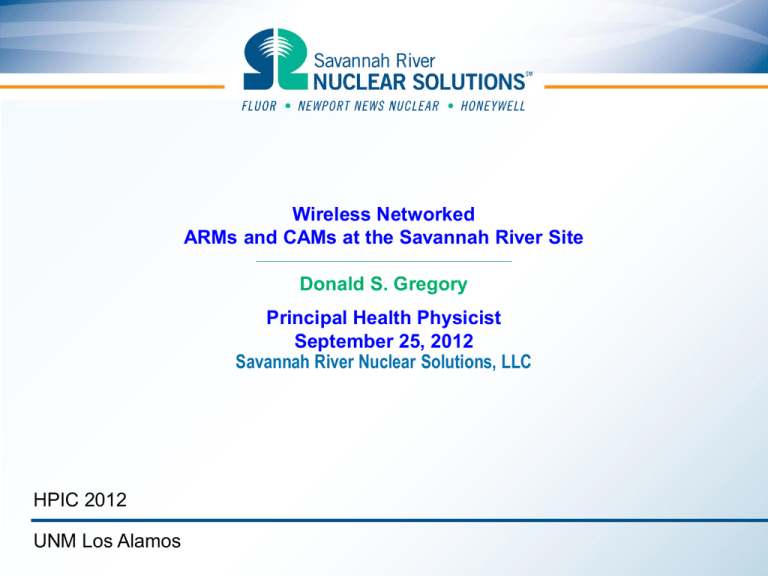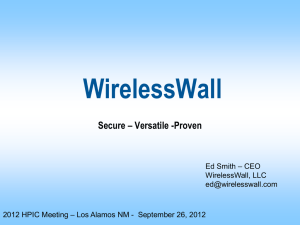Wireless Networked
advertisement

Wireless Networked ARMs and CAMs at the Savannah River Site Donald S. Gregory Principal Health Physicist September 25, 2012 Savannah River Nuclear Solutions, LLC HPIC 2012 UNM Los Alamos Background The Savannah River Site, a 310 square mile site, is located in the south eastern coastal area of the United States in the state of South Carolina. It is bordered to the west by the Savannah River and Georgia, and is close to several major cities, including Augusta and Savannah.(GA.), Columbia, Greenville, and Charleston (S.C.). It is in an area residents refer to as the Central Savannah River Area, or CSRA. 2 Site Facts • • The site was built during the 1950s to refine nuclear materials for deployment in nuclear weapons. It covers 310 square miles (800 km2) and employs more than 10,000 people. It is owned by the U.S. Department of Energy (DOE). The management and operating contract is held by Savannah River Nuclear Solutions LLC (SRNS)(Savannah River Nuclear Solutions (SRNS), LLC - now a Fluor partnership with Honeywell, and Huntington Ingalls Industries (formerly part of Northrop Grumman)), and the Liquid Waste Operations contract is held by Savannah River Remediation, which is a team of companies led by URS Corporation. Reactor name Start-up date Shutdown date R Reactor December 1953 June 1964 P Reactor February 1954 August 1988 K Reactor October 1954 July 1992 L Reactor July 1954 June 1988 C Reactor March 1955 June 1985 3 Current and Future Missions • • • • • • • Home to the Savannah River National Laboratory. Contains the nation's only operating radiochemical separations facility. Tritium facilities are also the United States' only source of tritium, an essential component in nuclear weapons. The nation's only mixed oxide fuel (MOX) manufacturing plant is being constructed at SRS. When operational, the MOX facility will convert legacy weapons-grade plutonium into fuel suitable for commercial power reactors. On August 1, 2007, construction officially began on the $4.86 billion MOX facility. The current deadline for the completion of construction is 2014. Following startup testing, the facility would begin operations in 2016 with a disposition rate of up to 3.5 tons of plutonium oxide each year. The mission is supposed to end in 2035, although it could be extended to 2038. Major focus is cleanup activities related to work done in the past for the nation's nuclear buildup. Currently none of the reactors on-site are operating, although two of the reactor buildings are being used to consolidate and store nuclear materials. Future plans for the site cover a wide range of options, including host to research reactors, a reactor park for power generation, and other possible uses. 4 Accomplishments – RF Team • Don Gregory - pioneered the development and implementation of the RF Networking in Limited and Protected Areas at SRS DOE facilities. (Started project in 2003) • Pervis Rouse – Joined the team in 2005 to assist in further development/implementation. • Scott Rogers – Canberra has provided and continues to provide primary technical support to the effort. 5 First Step: Determining the Requirements DOE: Limited and Protected area’s systems must be FIPS 1402 compliant. • • DOE requires Radio Frequency (RF) transmitting equipment used in Limited Areas, Protected Areas or Higher to be certified compliant with Federal Information Processing Standards (FIPS) 140-1 or 140-2. NIST FIPS 140-2 Validation Certificate 311 validates that the Cranite Wireless (Wireless Wall) Access Controller is FIPS 140-2 compliant. SRS DOE: SSID must be non-descriptive and hidden. RF Network System can not be connected to the Site Network System. Limited access and control of Facility specific encryption credentials (Wireless Wall 4 specific security files). Controlled user name and password protection. 6 First Step: Determining the Requirements (cont.) RF transmissions less than 1 Watt (30dbi). All RF transmissions should be greater than 100ft from any classified processor. • Can be 50ft with increased restrictions and annual approval All IP addresses used should be from a specific block of Fixed IP Addresses issued by Computer Security. SRS Radio Group has to approve the radio frequency and channel for each application prior to testing and installation 2.4GHz. 7 Second Step: Getting the RF Network System Approved A Test Plan out lining the proposed test of the RF Network system was summited to DOE and Site Technical Security and Computer Security for approval After DOE initial approval, summit test plan to Site Contractor’s Technical Security and Computer Security, Cyber Security, Management, and Radio Shop for approval. After approval the test was completed by setting up a test RF Network system in an unrestricted area for testing, review and evaluation by: • DOE Technical and DOE Computer Security approval • Site Technical and Computer Security approval • Computer Cyber Security approval • Radio Shop RF frequency approval 8 Facility Testing Approval A Test Plan is then developed and summited for each proposed facility application detailing the information on the proposed testing: • Specific information on the RF equipment to be tested (make, model, quantity, and technical specification) • All test location including RF sensitive installed equipment and distance from all classified processors in the facility. • All equipment is removed from the facility at the end of each day’s testing. • Coordinate testing with facility operations and technical security and security force. 9 Facility Testing Approval (Cont) • Develop documentation for approval for Temporary installation and testing of the RF Network: • DOE Technical Security • DOE Computer Security • Site Technical Security • Site Computer Cyber Security • Facility Technical Security • Facility Operation • Security Force • Radiological Control Operation • Radio Shop 10 Post Testing • Develop documentation for approval for installation of the RF Network: • DOE Technical Security • DOE Computer Security • Site Technical Security • Site Computer Cyber Security • Facility Technical Security • Facility Operation • Security Force • Facility Radiological Control Operation • Radio Shop 11 Final Step Testing • Testing the RF communication with each component in the RF Network system. • Testing the alarm capability of each component both in the field and at the Base Station. • Testing the failure indication for each component both in the field and at the Base Station. • Verify each component transmits all required information. • Verify Two way communication with Thermo Fisher RMS3C5 Area Radiation Monitor. • Verify Spectrum on Canberra ALPHA CAM. 12 Cost Savings: Selling Points Initial cost avoidance of hard-wired networked system installations. • Much less expensive than the installation of hard-wired systems. This is particularly true for older existing radiological facilities. • For D&D (Decommissioning and Demolition) Facilities, Wireless Systems can be removed before building demolition and be re-used. Reduced man-hours and materials associated with source checks and alarm responses for ARMs and CAMs. • Using the Eberline RMS3/DA1-6CC Area Radiation Monitor Source Checks can be preformed remotely; Alarms can be acknowledged and the status of the entire network checked remotely prior to leaving the RCO office and/or Control Room. Can have multiple access points to facilitate facility operational requirements. 13 ALARA: Selling Points Reduced worker radiation and contamination exposure. • Following an alarm RCO can perform initial investigation without entering an unknown radiation or airborne contamination condition. Routine operational checks and source checks on ARMs can be performed without entering a radiation area. Routine operational checks and alpha spectrum can be viewed on Alpha CAMs before entering the contamination area. 14 Operational: Selling points Improved Facility operational control. • For ARMs and CAMs the alarm and operational status of the network can be checked at the operational center or any access point. The Control Room and the RCO office can get alarms and have full access to the information at the same time and avoid notification errors. Improved alarm and operability communications. • The status and operability of the monitoring equipment can be checked real-time. Changes in radiological condition on special jobs or operations can be monitored closely. 15 Operational Selling Points (Cont) Flexibility in the deployment of equipment. • Relocation of portable and fixed monitoring equipment can be completed quickly reducing exposure to radiation and contamination. Operational data electronically archived and will enhance reconstruction of events and job planning. • Operational data is date/time stamped and electronically saved daily. In the event of an incident the operational data on all of the associated equipment can be reviewed. Previous events/jobs can be critiqued to reduce exposure and time in the area. 16 Component List • ASUS VMWare Complete Workstation – Windows XP- Office Suite and Canberra/Aquila RadHawk, Wireless Wall-Linux Program. • Windows XP and Linux Server. • Canberra Alpha Sentry Manager ASM1000, Canberra Alpha Sentry Continuous Air Monitor Sampling Head, Thermo RMS3 • D-Link 4-Port Ethernet Switch • Cranite’s (Wireless Wall) FIPS 140-2 Compliance Certificate • Proxim ORiNOCO Mosel Ap-4000 Access Point • ORiNOCO Model Classic Gold, PC Card • Aquila, RadComm/Code Talker RF Interface 17 RF Systems CANBERRA AQUILA/Wireless Wall • Applicable for most RME (ARMs, CAMs, ICAMs & PCMs), but is not limited to RME. • FIPS (Federal Information Processing Standard) 140-2 Compliant - for use in all Areas (including Limited and Protected Areas). • Can support multiple access points • Network is easily expanded (at a later date as equipment is added) • Fixed or Portable Application • SRS first DOE facility to install and operate wireless networking of radiation monitoring equipment in Limited and Protected Areas and approved by DOE. 18 CRANITE - WIRELESS WALL • Provides government certified security software for WLANs • Wireless Wall carries a FIPS 140-2 rating. FIPS is short for Federal Information Processing Standards; the 140 cryptographic standard was created by the National Institute of Standards and Technology (NIST). The standard has four levels of security - Level 1, Level 2, Level 3, and Level 4 -- that increase in quality as they go up. FIPS 140-1, the first level, only supports DES and 3DES encryption. The various levels are suitable for a wide array of areas in which cryptographic modules could be used. • Wireless Wall generally comes with three pieces: the policy server, an access controller for each subnet of the network, and client software for each PC/Code Talker. 19 RADHAWK CLIENT - Features • • • • • • • • • • • Windows Based Application RadNet Compliant RadNet - is a non-proprietary protocol that utilizes standard Internet protocols Remote monitoring of up to 256 instruments User-definable colors, alarm sounds, backgrounds and tab hierarchy Timeout alarm (communication failure) Multiple password levels Data logging Spectrum panning and logging (Normal spectrum and Alarm spectrum saved Windows® 2000 and XP Accessible via wired or wireless Ethernet LAN Able to accommodate non-RadNet compliant devices via Code Talker hardware (exp, Canberra Alpha CAM) 20 RadNet Packet Types Currently Supported • • • • • • Alpha CAM Beta CAM Gamma Area Monitor Gamma Criticality Monitor Neutron Area Monitor Neutron Criticality Monitor 21 RF Systems in Service Thermo Fisher RMS3 ARMs in 105-L (Protected Area) Basin Canberra Alpha CAMs in 105-K (Protected Area) ARM and CAM demo System 735-2B Canberra Alpha CAMs F-Canyon TRU Waste Remediation Project (Limited Area) 22 Pending RF Deployment Alpha CAMs and ARMs in H-Canyon testing is complete and design change approved and all RF equipment procured (26 RMS3 and 20 CAMs, Limited Area). HB-Line is awaiting facility approval for testing (Limited Area). RMS3 installation and scheduling is in progress at H-Tank Farm, Equipment procured. F-Tank Farm is awaiting facility approval for Risk Assessment testing. E-Area Burial Ground is in planning. 23 K-Area – Nuclear Material Management 24 K-Area – Nuclear Material Management 25 Portable Alpha CAM – Original Design Omni Antenna ASM1000 CAM Head RF Transmitter 26 Front View - New Portable ASM1000/AS1700R Unit Omni Antenna CAM Head RF Transmitter ASM1000 27 Side View CAM Head Omni Antenna ASM1000 RF Transmitter 28 Additional Views 29 Canberra/Aquila Code Talker RF Transmitter Gasket Seal NEMA 4 Enclosure Mounting Bracket & Clips FIPS Encryption RF Card Dimensions 9.6” x 6.6” x 2.6” AC Power Adapter Antenna Cable Computer, RMS3 RS232, or CAM RS232 Cable 30 Proxim Orinoco AP-4000 Access Point - Repeater In computer networking, a wireless access point (WAP) is a device that allows wireless devices to connect to a wired network using Wi-Fi, Bluetooth or related standards. The WAP usually connects to a router (via a wired network), and can relay data between the wireless devices (such as computers or printers) and wired devices on the network. 31 Diagram of Portable RF RMS3 The RMS-3 is an area and criticality radiation monitoring system designed to provide early warning if a hazardous condition develops. 32 HTF Portable RMS3 ARM Omni Antenna Directional Antenna Detector RF Transmitter RMS3 33 First portable VAMP Cart Conversion without RF capability VAMP - Victoreen Area Monitor Packet 34 Old VAMP Cart to be converted to RMS3 30”w x 30”h x 9”d 20”w x 16”h x 9.5”d 35 TYPICAL AQUILA/WIRELESS WALL RF NETWORK 36 Examples of HTF West Hill RF RADHAWK – Screen Shots 37 Examples of HTF East Hill 38 Radhawk Display 39 RMS3 40 RMS3 41 RMS3 42 Contacts Don Gregory Technical Lead Principal Health Physicist Building 735-2B Savannah River Nuclear Solutions Aiken, SC 29808 (803)952-8395 e-mail: donald.gregory@srs.gov Pervis Rouse, RRPT Senior Health Physicist Building 735-2B Savannah River Nuclear Solutions Aiken, SC 29808 (803)952-8810 e-mail: pervis.rouse@srs.gov 43







